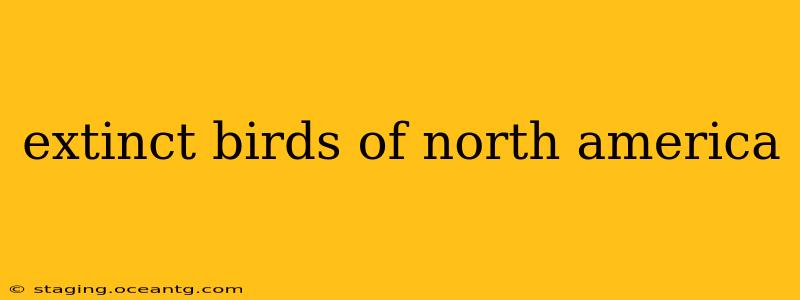North America, a land of vast and diverse ecosystems, has sadly witnessed the extinction of numerous bird species. These losses represent a significant blow to biodiversity and serve as a stark reminder of the impact human activity can have on the natural world. This exploration delves into the stories of some of these extinct birds, examining the causes of their demise and highlighting the importance of conservation efforts to prevent future extinctions.
What are some examples of extinct North American birds?
Several North American birds have met extinction, each with its unique story. Some prominent examples include:
-
The Passenger Pigeon ( Ectopistes migratorius): Perhaps the most iconic example of avian extinction in North America, the Passenger Pigeon once numbered in the billions. Their incredible flocks darkened the skies, but overhunting and habitat destruction led to their extinction in the early 20th century. The last known Passenger Pigeon, Martha, died in captivity in 1914.
-
The Carolina Parakeet (Conuropsis carolinensis): This vibrantly colored parrot was once widespread across the eastern United States. Habitat loss, coupled with persecution from farmers who viewed them as agricultural pests, ultimately led to their extinction around 1918.
-
The Great Auk (Pinguinus impennis): This flightless bird, inhabiting the North Atlantic, was hunted to extinction for its meat, feathers, and oil. The last known pair was killed in 1844.
-
The Labrador Duck (Camptorhynchus labradorius): The reasons for the extinction of this sea duck remain somewhat mysterious, but it's likely a combination of factors such as overhunting and habitat changes contributed to its disappearance by the late 19th century.
-
The Eskimo Curlew (Numenius borealis): This long-distance migrant suffered a drastic population decline due to overhunting and habitat destruction. The last confirmed sighting was in 1962, and it is now considered extinct.
What caused the extinction of these birds?
The extinction of these birds is primarily attributed to human activity. Key factors include:
-
Overhunting: Many species, such as the Great Auk and the Passenger Pigeon, were hunted relentlessly for their meat, feathers, or oil. Unsustainable hunting practices decimated populations beyond recovery.
-
Habitat Loss: The clearing of forests, draining of wetlands, and conversion of land for agriculture destroyed crucial habitats, leaving birds with nowhere to live and breed.
-
Introduced Species: The introduction of non-native predators or competitors can disrupt existing ecosystems, placing further pressure on native bird populations.
-
Disease: In some cases, disease outbreaks can contribute to the decline and ultimately extinction of bird species, particularly if combined with other stressors.
What are some lesser-known extinct North American birds?
Beyond the well-known examples, several other North American bird species have slipped into extinction, often leaving behind scant records. Research into these lesser-known extinctions continues to provide valuable insights into past ecosystems and the fragility of biodiversity. Examples include various subspecies of woodpeckers, sparrows, and other smaller birds whose populations were likely impacted by similar factors as the more famous examples listed above.
How can we prevent future bird extinctions?
Preventing future bird extinctions requires a multifaceted approach focused on conservation:
-
Habitat Protection and Restoration: Protecting existing habitats and restoring degraded ones is crucial for providing birds with the resources they need to survive.
-
Sustainable Hunting Practices: Implementing and enforcing sustainable hunting regulations helps prevent overexploitation of bird populations.
-
Combating Climate Change: Climate change is a significant threat to biodiversity, and mitigating its impacts is vital for the survival of many bird species.
-
Controlling Invasive Species: Managing and controlling the spread of invasive species helps protect native birds from competition and predation.
-
Increased Research and Monitoring: Continued research and monitoring of bird populations are essential for identifying species at risk and developing effective conservation strategies.
The extinction of these birds is a tragic reminder of the consequences of unchecked human impact on the natural world. By learning from past mistakes and implementing effective conservation measures, we can strive to protect the remaining avian biodiversity of North America and prevent future extinctions.
